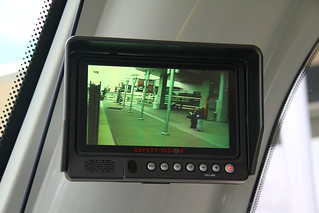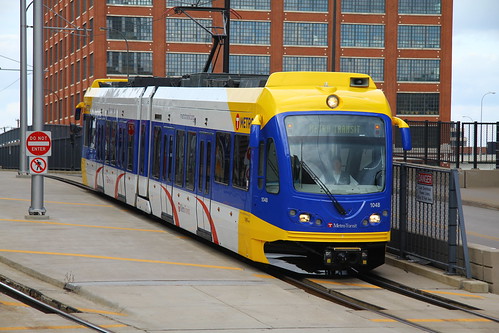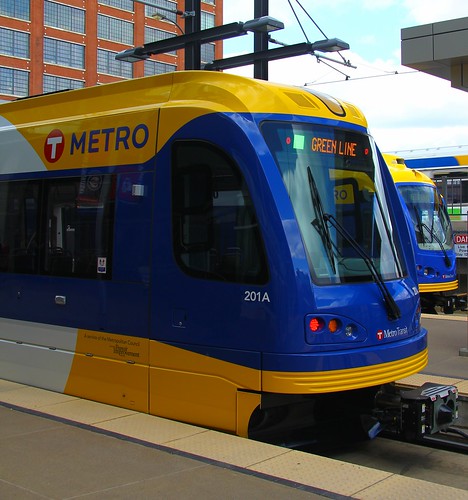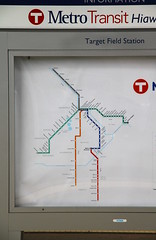Metro Transit officially unveiled their first new Siemens-built light-rail vehicle on Wednesday, previewing what most of the Twin Cities light-rail fleet will look like just a few years from now. It also marked the first showing of vehicles with the new "METRO" branding which will be used on light rail and bus rapid transit lines going forward. Both the new Siemens LRV and one of the original Bombardier LRVs showed up in a brighter paint scheme of yellow, blue, and light gray, but still following the general pattern established by the older units when they began service on the Hiawatha Line in 2004.
By now you may have heard the "Green Line" moniker that has been attached to the Central Corridor LRT project, and that the Hiawatha Line will soon be known as the "Blue Line". The Southwest LRT project is now being called the "Green Line extension", and the Cedar Avenue and Interstate 35W BRT services are planned to be known as the Red and Orange lines, respectively.
Those routes are going to be unified under the "METRO" name. This seems like an attempt to keep everyone thoroughly confused, though it does have a purpose: At least one of the BRT lines will be operated by the Minnesota Valley Transit Authority. The METRO system will represent a unified brand across two different agencies and service regions. It's an interesting political tool, but will any riders actually notice? We'll have to wait and see.
The new branding has been rolling out slowly and has been most noticeable up until now along the Green Line where information kiosks at new stations have incorporated the METRO name. While the train that rolled in to Target Field this week was described as "the first Green Line car", it will first see revenue service on the Blue Line. This first car actually arrived in the Twin Cities last month and has been undergoing some initial testing. Along with a second vehicle that arrived this week, the pair will be tested extensively, with overnight runs in the tunnels under MSP airport, before going into service around January. Later arrivals will probably only need about one month of testing each before being officially accepted into the fleet by Metro Transit.
59 vehicles are currently on order for the Blue and Green lines, and there are options in the contract for 40 more. The Hiawatha Line had 24 Bombardier LRVs operating by the end of 2004, but the line's ridership blew away expectations and Metro Transit ended up operating more trains and longer trains than anyone had anticipated. They were able to exercise options for 3 additional vehicles a couple of years later, but that was the maximum allowed in the contract. After those three were completed, Bombardier shut down the Flexity Swift manufacturing line for good, and Metro Transit has been making do with an undersized fleet for several years now.
12 of the new trains will go toward beefing up the Blue Line fleet, while the remaining 47 in the order are intended for the Green Line to Saint Paul. Most or all of the last 40 options will probably be picked up once the Southwest extension gets approved for funding.
Metro Transit has been preparing for quite a while to receive the new trains. The Franklin Avenue shops have been undergoing an expansion for the past year to make room for the new vehicles, and some operations that don't require direct access to the train chassis have been moved into a new Light Rail Support Facility about half a mile south. Some vehicles officially intended for the Green Line may have a temporary home by Franklin Avenue until the new maintenance facility in Lowertown Saint Paul becomes complete enough to receive the new trains.
The new trains have some improved features as well as reduced weight compared to their older counterparts. The older Bombardiers weighed in at 53 tons each, while the newer Siemens model is only 50. That reduction by 6,000 pounds should help with overall efficiency and reduce electricity consumption, though it falls short of what could be achieved. The Bombardier Flexity Swift model was primarily sold in Europe, and Metro Transit turned out to be the only American buyer. The LRVs on the other side of the Atlantic only weighed in at 41 tons. Federal regulations for crash requirements appear to be the culprit in porking out our original fleet as well as the newer vehicles, increasing energy consumption and adding extra wear and tear to the rails—and, of course, having the perverse effect of making it harder to absorb the energy of a crash in the first place.
The new Siemens S70 trains are a bit boxier than their elders in the fleet, which isn't to everyone's liking. However, they have been made a bit sleeker through the removal of rear-view mirrors, replaced by rear-facing video cameras with displays inside the cab.


The interior features light gray surfaces rather than the Bombardiers' yellow walls. The new trains have 68 seats rather than 66 in the Bombardiers. The seating arrangement has changed a bit, with seats up on the high-floor sections above the driving wheels facing toward the middle section of the vehicle, rather than the face-to-face seating found in the Type 1 cars. There is some face-to-face seating in the enlarged middle section of the Type 2 cars, though.


The new trains also have a beefier heating system than the Bombardiers, and the unit on display this week was actively pumping out heat as the media and other onlookers gathered to check out the first article on a fairly cool and blustery day. Improved insulation should help keep the interior warmer and quieter than older trains as well.
But I shouldn't forget to mention the Bombardier train painted in new colors which was also displayed on Wednesday. These trains will probably still be with us for another 20 years, and it was good to see them getting spiffed up with a new paint job. While I think the old paint scheme had aged relatively well, some trains have begun to look quite dirty despite getting washed on a regular basis. The old paint has been physically aging, and deserves a refresh.



No comments:
Post a Comment